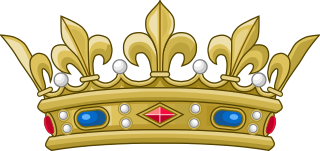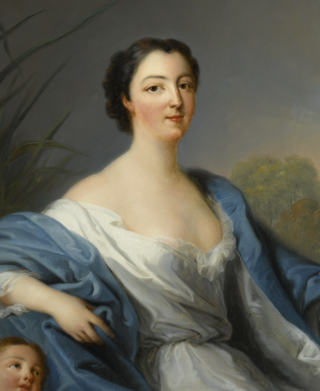Louise-Marie or Louise Marie may refer to:

Louis Joseph de Bourbon was Prince of Condé from 1740 to his death. A member of the House of Bourbon, he held the prestigious rank of Prince du Sang.

Fils de France was the style and rank held by the sons of the kings and dauphins of France. A daughter was known as a fille de France.

The 4th House of Orléans, sometimes called the House of Bourbon-Orléans to distinguish it, is the fourth holder of a surname previously used by several branches of the Royal House of France, all descended in the legitimate male line from the dynasty's founder, Hugh Capet. The house was founded by Philippe I, Duke of Orléans, younger son of Louis XIII and younger brother of Louis XIV, the "Sun King".

Marie Louise or Marie-Louise is a French feminine compound given name. In other languages, it may take the forms Maria Luiza, Maria Luisa, or Mary Louise (English). Notable people with the name include:

Louise Marie de La Grange d'Arquien was a French noblewoman, the elder sister of Marie Casimire Louise de La Grange d'Arquien, Queen of Poland.

Élisabeth Charlotte d'Orléans was a petite-fille de France, and Duchess of Lorraine and Bar by marriage to Leopold, Duke of Lorraine. She was regent of Lorraine and Bar during the minority (1729–1730) and absence of her son (1730–1737), and suo jure Princess of Commercy 1737–1744. Among her children was Francis I, Holy Roman Emperor, a co-founder of the royal House of Habsburg-Lorraine.

Louise Henriette de Bourbon, Mademoiselle de Conti at birth, was a French princess, who, by marriage, became Duchess of Chartres (1743–1752), then Duchess of Orléans (1752–1759) upon the death of her father-in-law. On 4 February 1752, her husband became the head of the House of Orléans, and the First Prince of the Blood, the most important personage after the immediate members of the royal family.

Elisabeth Therese of Lorraine was Queen of Sardinia as the wife of Charles Emmanuel III of Sardinia. She was born a Princess of Lorraine as the daughter of Leopold, Duke of Lorraine and Élisabeth Charlotte d'Orléans. She became the coadjutor bishop of Remiremont Abbey in 1734, before her marriage to Charles Emmanuel III. She died from puerperal fever, after childbirth.

A prince du sang is a person legitimately descended in male line from a sovereign. The female equivalent was princess of the blood, being applied to the daughter of a prince of the blood. The most prominent examples include members of the French royal line, but the term prince of the blood has been used in other families more generally, for example among the British royal family and when referring to the Shinnōke in Japan.

Louise Diane d'Orléans was Princess of Conti from her marriage to Prince Louis François in 1732, until her death in childbirth. She was the youngest child of Philippe II, Duke of Orléans and Françoise Marie de Bourbon, the youngest legitimised daughter of King Louis XIV of France and his mistress Madame de Montespan. She was born while her father was the regent for Louis XV. Some sources referred to her as Louis Diane.

Louise Élisabeth de Bourbon was a daughter of Louis III de Bourbon, Prince of Condé, and his wife, Louise Françoise de Bourbon, légitimée de France, a legitimised daughter of King Louis XIV of France and his famous mistress, Madame de Montespan.

Marie Thérèse de Bourbon was the titular Queen consort of Poland in 1697. She was the daughter of the Prince of Condé. As a member of France's reigning House of Bourbon, she was a princesse du sang.
The following is the Jacobite line of succession to the English and Scottish thrones as of the death of Anne, Queen of Great Britain, on 1 August 1714. It reflects the laws current in England and Scotland immediately before the Act of Settlement 1701, which disqualified Catholics from the throne.

Marie Anne de Bourbon, Duchess of Bourbon was a princess of the blood at the French court of Versailles. She was the first wife of Louis Henri, Duke of Bourbon. She died childless during the Regency of Philippe II, Duke of Orléans, who was her husband's uncle. Marie Anne was known as "the younger duchess" to distinguish her from her mother-in-law, Louise-Françoise de Bourbon. Despite her husband being the Prince of Condé, he continued to use the title of Duke of Bourbon, the title by which his wife was known.

Marie Anne de Bourbon was Surintendante de la Maison de la Reine to the French queen Maria Leszczyńska. She was the daughter of Louis III, Prince of Condé. Her father was the grandson of le Grand Condé and her mother, Louise Françoise de Bourbon, Mademoiselle de Nantes, was the eldest surviving daughter of Louis XIV of France and his maîtresse-en-titre, Madame de Montespan. She was known as Mademoiselle de Clermont.

The Royal Chapel of Dreux situated in Dreux, France, is the traditional burial place of members of the House of Orléans. It is an important early building in the French adoption of Gothic Revival architecture, despite being topped by a dome. Starting in 1828, Alexandre Brogniart, director of the Sèvres porcelain manufactory, produced fired-enamel paintings on large panes of plate glass for King Louis-Philippe, an important early French commission in Gothic Revival taste, preceded mainly by some Gothic features in a few jardins paysagers.

Anne Charlotte of Lorraine was the Abbess of Remiremont and Mons. She was the thirteenth of fifteen children of Leopold, Duke of Lorraine, and his spouse Élisabeth Charlotte d'Orléans. Her mother was the niece of Louis XIV of France and sister of Philippe II, Duke of Orléans and Regent of France during the minority of Louis XV.

Louise Adélaïde de Bourbon was a French princess of the Blood and member of the courts of Louis XIV and his successor Louis XV of France. She never married, but she had many illegitimate children.

Prince Charles d'Orléans, Duke of Penthièvre was the eighth child of the Duke and Duchess of Orléans, future Louis Philippe I and la Reine Marie Amélie. He was created Duke of Penthièvre, a title previously held by his great grandfather.